November 2014 – Volume 16, Issue 8: The Best of the U.S./China Climate Deal
IN THIS ISSUE
Flanigan’s Eco-Logic
Decarbonizing California: 2020-2050
Global Factors
Global Warming Solutions
Environmental Justice
Decarbonizing the Pipelines
Energy Efficiency: The First Step
California’s Transportation Focus
Electric Vehicles
Climate and Land Management
Taking Action

Flanigan’s Eco-Logic: The Best of the U.S./China Climate Dea
U.S. Representative Henry Waxman said that we may look back at the U.S.-China Climate deal of November 2014 and “see it as a turning point on climate.” This may be especially true if other nations follow suit. Together, according to the Brookings Institute, we’ll be on track to cut emissions 80% from 1990 levels by 2050, the minimum reduction that IPCC scientists believe can avert the greatest temperature rises. At last the climate negotiations and the upcoming accord in Lima, Peru at the upcoming COP (Conference of Parties) will include the leading emitters, the two countries that are responsible for more than a third of global emissions.
Apparently a number of factors led to Secretary of State John Kerry sensing a new receptiveness on the part of the Chinese to discussing climate change. China has become the world’s largest emitter… and its leaders can no longer turn the other way on air pollution. Severe air pollution in China has become a source of domestic discontent, and an international embarrassment. For the recent international meetings in Beijing, industries were closed, drivers could only do so on alternate days, even cremations were suspended to clear the air.
Through the deal, the United States has pledged to cut emissions by at 26 – 28% by 2025, doubling the current pace of carbon reduction. China’s President Xi Jinping pledged to step up China’s timeframe for GHG reductions, and will invest heavily in non-fossil fuels… namely nuclear, hydroelectricity, and other renewables. It will reach its maximum emissions by 2030 if not before – earlier than projected — while making sure that non-fossil fuels achieve 20% of the country’s total by 2030. For perspective, China will have to bring on 1 GW of non-fossil capacity per week for the next 15 years, and at that time its non-fossil portfolio will be equivalent to total U.S. power generation.
So celebrate. I am relieved. This is a time of Thanksgiving. It’s not a time to be unrealistic in the least. There will still be major challenges. But there’s not just hope but promise that the great nations of the world will indeed rise to the greatest challenge facing our global civilization. The leaders of the great economies are confident that they can grow their economies while addressing climate change.
The big picture needs to be reinforced by our actions. Continue to lead by example. Now with the support of the most relevant nations, the actions we take at the micro level are all the more valuable to the winning scissor effect of top-down policy (“grass-tops”) and grass-roots action. Let’s make every home a vibrant part of a vibrant, decarbonized future.
Quote of the week:
“The China/U.S deal on greenhouse gases could set the stage for the arms race of clean energy, each nation fighting for market shares.”
– Lauren Faber, Environmental Defense Fund
Decarbonizing California: 2020-2050
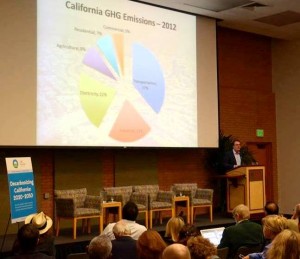
Jonathan Parfrey kicks things off
Proud to be a Californian was an overriding emotion that day. It’s had a lingering effect too. The gathering was also buttressed by recent news on the U.S./China Climate Deal. A break-through.
This conference – Decarbonizing California: 2020 – 2050 was cutting edge and potent. The people assembled knew they had to be there. I was pleased to be among them… and I was humbled: These are really the Californians who have worked hard to affect change, to support AB 32, and to make California the global leader in commitments to emissions reduction.
Jonathan Parfrey of Climate Resolve had convened the ultimate force, about 400 of the right people, to tackle the State’s most ambitious goal…perhaps since train tracks blasted through the Sierras. The conference, held at University of Southern California, was about Californians taking action – going “double and quadruple down” — and preparing to reduce emissions by 80% by 2050.
The choir we were. Clearly. So why meet and plan for a 30-year period that doesn’t begin for six years? Parfrey was firm in delivery: “There is a need for a counter-veiling force opposed to those trying to harm AB 32.” We’d hear this again and again all day: There are still deniers out there focused on dismantling the Global Warming Solutions Act. Occurred to me, perhaps AB 32 is the Obamacare of environmental concerns. Andy Lipkis said later in the day, “We seem to be experiencing a resurgence in denial.”
Jonathan Parfrey is a born leader, with a unique – perhaps understated style – that is warm while both realistic and optimistic. He’s also proud to be a Southern Californian. “LA was inevitable given this much natural beauty and its blessed weather. It had to come into existence,” he explained. And it got messed up with rampant pollution. Now we have to make it shine in new ways… without carbon. Parfrey is confident that LA can rise to the challenge.
Climate Resolve is LA’s climate change organization. Climate Resolve is at the nexus of science and policy; Jonathan Parfrey is a great interpreter: “Weather is like your mood, the mood you’re in… up, down, stormy, sunny, hot, dry, wet.. Climate is your personality… the way you are all the time.” He cites the work of Dr. Alex Hall at UCLA. Hall downscaled studies to see the projected climate impacts at LA neighborhood levels. By 2050, there will be three times as many extreme heat days as we have now.
Climate Resolve is focusing on ways to affect change. Its C-CHANGE LA campaign is about increasing the quality of life through things like cooler playgrounds and neighborhoods, sidewalk cafes and such, while decreasing emissions. “Germany is already at 30% renewables, with more than 300,000 jobs.” Jonathan is resolved: “We can do all of this at once and have a strong economy.”
Global Warming Solutions
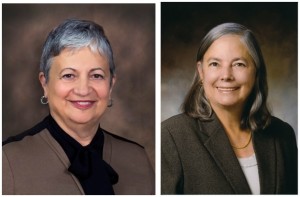
Mary Nichols and Fran Pavley
A highlight of the conference for me was the presence of two leaders in particular, Mary Nichols and Fran Pavley. Mary Nichols, chair of the California Air Resources Board, is warm, understated, clearly kind and caring, and powerful. Her job is to implement AB 32 to achieve 1990 levels of greenhouse gases (GHG) by 2020. She brought rich perspectives to the conference.
“We are on a path that will certainly hit our goals by 2020.” Amazing news that we somehow have come to take for granted. Mary Nichols noted that “it looked really, really hard when it was signed in 2006.” The bill was intended to provoke change… and indeed it has. Nichols says the biggest breakthrough is the cap and trade emissions trading system. This year $870 million will be disbursed to reduce GHGs through cap and trade. Nichols believes that the most pressing need is addressing motor vehicles as transportation accounts for 37% of California’s GHG emissions. Electricity is 22% in comparison.
Already much has been done with low carbon transportation fuels. California has a history of being ahead of the U.S. EPA on clean air act regulations – and maintaining an exemption from EPA’s less stringent rules as a result. That’s good according to Nichols. “We’re able to go deeper.” And overall, she believes that AB 32’s practitioners have used the right science, they’ve adequately studied impacts, launched mechanisms to reel in emissions.
Lauren Faber of the Environmental Defense Fund chimed in with good news: California’s economy is up, and emissions are down… People said that would not happen.”
Nichols cautioned those in the room to be steadfast, the work continues. With electrification we’re looking to power a lot more than we power now. And California’s population is expected to grow from 38 million today to 50 million by 2050. “The low-hanging fruit has always been picked,” said Nichols with a grin. There are things to do now that will be easier now than waiting until 2050. Others things just take longer, and thus may seem less worthwhile. Nichols is pushing for a mid-term goal on the way to 2050.
Denise Fairchild of the Emerald Cities Collaborative pointed out that California is actually #2 in energy efficiency. EcoNet readers already knew this! And Los Angeles is rated 28th of major metro regions for sustainability. “We’re in the middle of the pack… not doing enough at the community level,” she said. “But if we can fix this basin, California will clearly be #1 in the nation.”
Global Factors
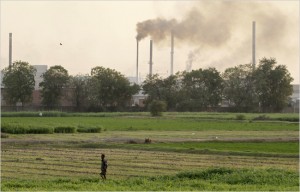
India is #3 in emissions
Mary Nichols was just back from India . She was there when the U.S./China climate deal was reached and announced. She reported that “jaws dropped” as Indian officials realized that with the largest and second largest emitting nations banding together, India at #3 would soon be on the hot seat.
India has taken a laggardly position on greenhouse gas abatement. The situation on the ground there is very real. Many citizens have no electricity at all, many more have unreliable electricity. As the country developments, there will be growth in electricity demand. If done with conventional fuels, the emissions growth will dwarf anything we can do in the U.S. to eliminate them. India needs to grow in ways that do not swamp all other international efforts.
California, with a world economy that would put it in the G8, must lead and show that economic prosperity – in this case India’s electrification – can be done in concert with greenhouse gas emissions reduction and elimination. Mary Nichols made it clear: “California’s leadership on this issue is important to the planet.” We are the test bed, at the cutting edge of clean and green power and energy.
India will have to work hard to cut emissions while maintaining sustainable aspects its society. India’s share of bike use is going down. (The same is true in Beijing.) The bike industry in India is in trouble. So are India’s once-great railroads. Freight no longer can rely on trains, thus diesel trucks absent of fuel standards dominate.
Environmental Justice
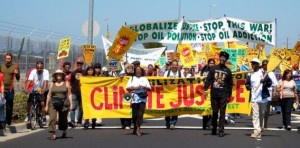
Environmental Justice Rally
Throughout Decarbonizing California there was the steady beat of the drum of environmental justice: The future of climate must be integrated with a social justice paradigm. There are five million Latinos in Los Angeles that must be part of the solution.
Denise Fairchild warned, “Let’s not create a two-tiered energy society.” Our task is to make low-income and people of color to be part of the solution. How can we make their homes more efficient? Let’s not skip over these hard-to-fix homes. Thus far, only the rich have Priuses and solar systems.
An interesting policy question emerged: With such deep reductions needed in energy use in our housing stock, “Do we invest in incremental retrofits in old buildings at all?” To achieve climate goals, should they be completely replaced rather than retrofitted?
Decarbonizing California exhibited a great sensitivity to environmental justice (EJ). This cannot be an elitist movement. Its goals are huge and need to reach out to all citizens. Several advocates want to completely eliminate the use of fossil fuels, notably the Sierra Club and EJ groups such as Communities for a Better Environment. The LA Bus Riders Union was represented, promoting ideas of how to make bus travel more ubiquitous, such as promoting bus-only lanes and free public transport without gun-toting sheriffs.
Decarbonizing the Pipelines
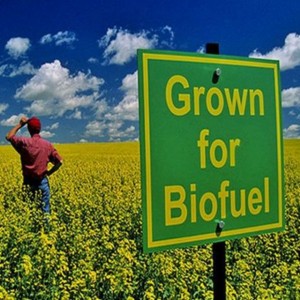
Crops can be grown for methane
George Minter gave a profound speech on the role of Southern California Gas in decarbonizing California. The massive utility serves 21 million people with 6 million meters. It’s the largest gas company in the United States. And it has been cleaning the air for 50 – 60 years and is proud of it!
Awash, natural gas is being used to replace fuel oil, diesel, and coal. It is cleaning the air. Minter challenges the head-long surge toward electrification. While appropriate in many cases, it’s not the goal. Reducing emissions is. Natural gas has a record of being used effectively in mobile and stationary sources very effectively. Google is now 100% solar and fuel-cell powered.
It’s hard to imagine a natural gas company that is carbon-free. It’s hard to imagine a job at a gas company in which your role is to go carbon-free. How the heck do you get there? How to decarbonize the pipeline? Minter presented his vision for a carbon-free pipeline.
The first step is to tap biofuels. They are abundant and can be further exploited to large degree. This includes methane from landfills, treatment plants, agricultural wastes, wastes from urban centers, and woodlands. Minter estimates that biomethane can contribute 20% of his company’s gas supply.
The second step involves “purpose-grown crops.” These are purposefully grown for methane production. Things like switch grasses and algae can contribute another 20%. Now we’re at 40%.
The third step in unthinkable: Producing renewable methane from renewable electricity. This involves the hydrolysis of water using excess solar power, then methanating the hydrogen, and injecting it into natural gas pipelines. This “power to gas” concept then becomes “gas to heat” and “gas to transport.” It’s a systems solution that stretched participants’ thinking.
Minter ended by stating that, “I challenge you to back off the predisposition that natural gas is a nasty fossil fuel. It isn’t.” The bottom line is that you can move electrons, and you can move molecules of gas. Both can be renewably generated in the current account.
Energy Efficiency: The First Step

EcoMotion Emissions Time Bomb
There are clear win-win solutions for climate protection. I was pleased to present “Energy Efficiency as the First Step in Decarbonizing California,” a 60-slide deck. I did so humbly, realizing the vast experience of those in the room, many with lots of “skin in the game” in California. Efficiency is basic, and often highly cost-effective. Measures to “get our houses in order” constitute the first step in climate protection.
My first-step presentation is in four parts: It focuses on the critical nexus between technological and behavioral aspects of net zero use. Images and stories of the power of the Emissions Time Bomb as a motivational display are next. I then discuss how EcoMotion is helping Millbrook School, an idyllic prep school in the farm country of New York, go carbon neutral.
I wrap with Climate Smart Schools, a partnership between EcoMotion and Climate Resolve focused on helping schools in Southern California go green, saving energy, money, while protecting the environment. Thanks to special funding for K-14 schools in California – a segment of the power-consuming economy that has long been neglected, marked by deferred maintenance, not to mention high-performance retrofits – Climate Smart Schools is seizing an opportunity to meld hard-wired efficiency gains with student and school community engagement. Sharing the podium with David Jacot, Director of Efficiency Solutions for Los Angeles Department of Water and Power, the role of efficiency as a least-cost, quick-impact, scalable carbon mitigation resource is clear.
California’s Transportation Focus
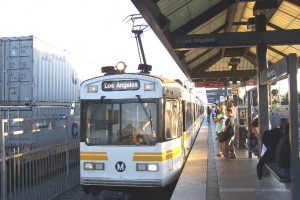
LA light rail is being expanded
State Senator Fran Pavley is a California treasure. A former school teacher, unpretentious, a sparkle in her eye… “Kudos to all the environmental activists… we need you!” she began. The role of NGOs and other advocates has been essential to her Low Carbon Transportation Fuels regulation, and for the passage of Assembly Bill 32, the Global Warming Solutions Act of 2006.
Pavley urged those at the conference to now focus on mobile emissions sources. This is our State’s biggest challenge: One in ten autos sold in America is sold in California. “I think sometimes that they are all on the 405,” she joked. This is the state that needs to take a leadership role, particularly on transportation. Since we predate the Clean Air Act, Pavley underscored that we can implement more stringent standards. We are one of five states with a full-time legislature, able to tackle sophisticated challenges like this.
Denny Zane, Executive Director of MoveLA, was passionate. Former Mayor of Santa Monica, he was the leading organizer of Measure R that has funded $40 billion for Los Angeles County over a 30-year period. Fully 70% of this is for transit. Zane explained that it passed by points, garnering 67.8% of the vote when a two-thirds majority was required. It was approved alongside the election of President Barrack Obama.
Measure R is doubling the light rail system in Los Angeles in ten years. Five lines will be simultaneously under construction in Los Angeles next year. “This is a propitious moment for our state.” Now Zane is working on Measure R2, a massive bond measure slated for the 2016 ballot that will take transport efficiency to the next level in Los Angeles. It will also address biking and pedestrian access, clean freight, and bus system upgrades.
Electric Vehicles
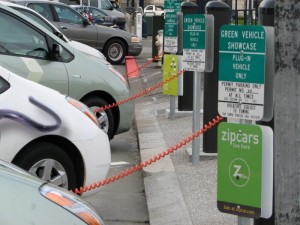
More charging stations are planned
Throughout the conference was the recognition of the huge role of electric vehicles (EVs) in the carbon equation. Tim O’Connor of the California Climate Initiative added perspective: AB 32 will essentially take oil companies out of business. They must adapt… And so must the car companies. Utilities must prepare for increased electrification of the transportation system.
LADWP has pledged to stop coal, but at this time is still 40% coal-fired. According to Chief Sustainability and Economic Development Coordinator Nancy Sutley, even with the current generating mix, EVs are still much cleaner way to power transport than internal combustion engines. LADWP is now launching a $2 million rebate program for Level 2 fast chargers.
Governor Jerry Brown has set a goal for 1.5 million plug-in EVs by 2025. Southern California Edison – which sees EVs as “good load” – plans to add 30,000 chargers in its service territory in the coming years. Its goal is to address and allay potential buyers of EVs of “range anxiety.”
While Teslas are all the rage, a presentation on fuel cell vehicles caught my attention. What happened to this promising energy carrier? EVs with battery packs have stolen the spotlight, but according to the California Fuel Cell Partnership, 2015 will be a break-out year. Several companies will launch hydrogen fuel-cell powered vehicles. A Hyundai can be leased for $500, and unlike battery-power EVs, refueling time for fuel cell EVs is 10 minutes for a range of 300 miles.
Climate and Land Management
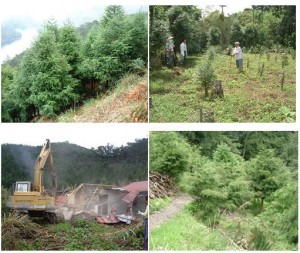 Gary Gero, Executive Director of the Climate Registry noted early in the day that while not the focus of the conference, deforestation is responsible for 15 – 20% of global emissions. Forests are a big deal in the climate equation. Luis Blumberg, director of climate change for the California chapter of The Nature Conservancy, discussed the missing element in most climate talks, that of sound land management.
Gary Gero, Executive Director of the Climate Registry noted early in the day that while not the focus of the conference, deforestation is responsible for 15 – 20% of global emissions. Forests are a big deal in the climate equation. Luis Blumberg, director of climate change for the California chapter of The Nature Conservancy, discussed the missing element in most climate talks, that of sound land management.
How much carbon can and does the land can store and sequester? Land management takes many forms from managing forests, range lands, and our rich wetlands. Blumberg made clear that another aspect of Decarbonizing California is “re-carbonizing,” putting carbon back in the ground and in the trees where it came from.
One-third of California is in forests. California has over 33 million acres of forest and there are many needs for forest management. Key among them is preventing fires that spew emissions and squelch sequestration. Forest fires can also force closure of transmission lines. Forests act as a sponge for greenhouse gases. The same is true for water which trees store and then release slowly. Redwood forests top the charts for carbon sequestration. They sequester 500 tons of carbon dioxide per acre per year.
In California, our urban trees sequester 4.3 million metric tonnes of CO2e per year. They also provide a cooling benefit thanks to their shade: Studies show that the average tree saves 28 kWh/year in avoided cooling costs. Cap and trade has $92 million allocated for urban forestry this year. Blumberg concluded by noting that, “The world is watching California say Blumberg, we are recognized as a global leader.” Now it is time to protect natural landscapes and to be fully cognizant of their role in GHG reductions.
Taking Action
Click here to add your own text
